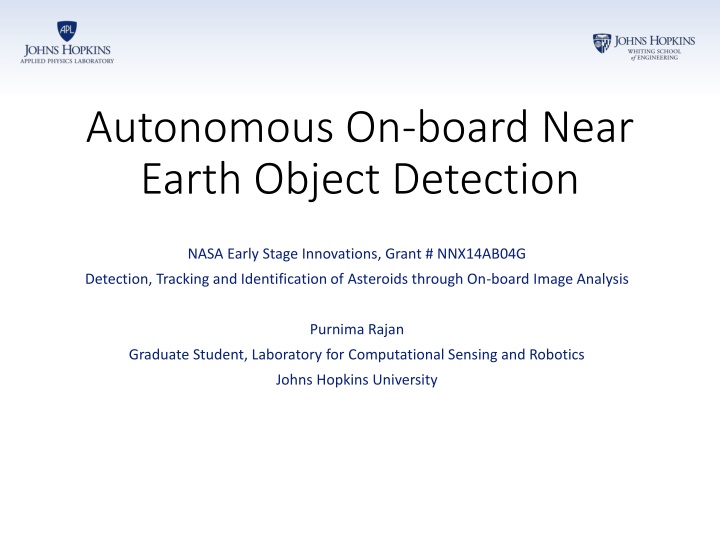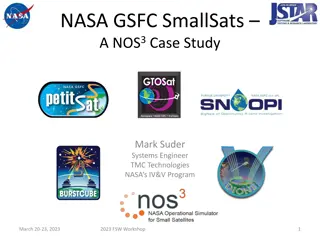
Autonomous On-board Near Earth Object Detection Research at NASA
Explore the innovative research on autonomous on-board near-earth object detection conducted by NASA's Early Stage Innovations program. Discover how cutting-edge algorithms and image analysis techniques are being utilized to detect, track, and identify asteroids in space.
Download Presentation

Please find below an Image/Link to download the presentation.
The content on the website is provided AS IS for your information and personal use only. It may not be sold, licensed, or shared on other websites without obtaining consent from the author. If you encounter any issues during the download, it is possible that the publisher has removed the file from their server.
You are allowed to download the files provided on this website for personal or commercial use, subject to the condition that they are used lawfully. All files are the property of their respective owners.
The content on the website is provided AS IS for your information and personal use only. It may not be sold, licensed, or shared on other websites without obtaining consent from the author.
E N D
Presentation Transcript
Autonomous On-board Near Earth Object Detection NASA Early Stage Innovations, Grant # NNX14AB04G Detection, Tracking and Identification of Asteroids through On-board Image Analysis Purnima Rajan Graduate Student, Laboratory for Computational Sensing and Robotics Johns Hopkins University
Research Objectives & Results Research Objectives & Results Objectives Develop asteroid detection, identification, and tracking algorithms that can be hosted on a spacecraft Implement the algorithms on the flight-like environment to demonstrate feasibility of on-board asteroid detection Apply machine learning techniques to minimize false positives Results Detection algorithm can fit on a MCP-750 (233 MHz) Developed a tool suite that enables instrument and spacecraft design trades 2
Outline Outline Algorithm Description Algorithm Performance and Analysis Ongoing / Future Work 3
Image Processing Pipeline Image Pre- Processing Trajectory Detection Image Differencing Image Assumptions: A sequence of 3 or more overlapping images is taken The SNR and imaging conditions are such that the asteroid is visible (even if faint) 4
Image Processing Pipeline Image Processing Pipeline Input Image Sequence Input Image Sequence Image Pre- Processing Image Differencing Trajectory Detection Image 2002 CY46 Triplet (FITS images) Near Earth Asteroid Tracking(NEAT) system archive 5
Image Processing Pipeline Image Processing Pipeline Image Pre- Processing Image Differencing Trajectory Detection Image Image Pre-Processing Median filter Dynamic thresholding at mean plus 1 SD brightness 6
Image Processing Pipeline Image Processing Pipeline Image Pre- Processing Image Differencing Trajectory Detection Image ??) 2 Logical Differencing: di = bi & ~C, where C = ( ? 7
Image Processing Pipeline Image Processing Pipeline Image Pre- Processing Image Differencing Trajectory Detection Image Replace each connected component by its center of gravity Filter on size/shape 8
Trajectory Detection Trajectory Detection Image Pre- Processing Image Differencing Trajectory Detection Image For each KC2 pairs of images Ik, Ij For each detection pair (dk,n, dj,m), dk,n in Ikand dj,m in Ij V=0 For each Is, s k,j Find the point of intersection ds in Is, s k,j If detection within 5x5 neighborhood of ds V=V+1 If V > Vmin Record (dk,n, dj,m) as a detection 9
Trajectory Detection Trajectory Detection Image Pre- Processing Image Differencing Trajectory Detection Image Trajectory Detection for superimposed CY46 Triplet. Asteroid trajectory detected is shown in green. True location is in red. 10
Trajectory Trajectory Detection Triples vs. Quadruplets Triples vs. Quadruplets Detection Image Pre- Processing Image Differencing Trajectory Detection Image Left: Trajectory Detection for the CSS Triplet. Right: Trajectory Detection for the CSS quadruplet. Asteroid trajectory detected is shown in green. True location is in red. 11
Algorithm Validation Approach Algorithm Validation Approach Program Waveband Time series Available data sets Ground truth availability Available raw (level 1A) data Near Earth Asteroid Tracking(NEAT) 400-900 nm (visible) 20 minutes 13 triplets yes None Catalina Sky Survey(CSS) visible ~10 mins 2 quadruplets yes None Pan-STARRS .5-.8 microns (visible) ~30 mins Pairs only no None NEOWISE 3-4 microns ~2 hrs ~30 images per sequence no None Real imagery that met our assumptions was very limited Majority were ground-based telescopes (NEAT, CSS, Pan-STARRS) Difficult to obtain NEOWISE (space-based) imagery that met our assumptions None in optimal waveband (6-10 micron) Employed simulated imagery to provide statistical analysis 12
Outline Outline Algorithm Description Image Simulation Algorithm Performance and Analysis Recommendations Ongoing / Future Work 13
Performance Analysis Performance Analysis Extensive testing as a function of telescope parameters and asteroid characteristics Chose 0.5m aperture as best tradeoff of detection vs. size ROC curves True Positives per sequence is the mean number of true asteroid detections in each image in the sequence. False Positives per sequence is the mean number of false detections in each image in the sequence. 14
Performance Analysis Performance Analysis Stratified ROC curves based on asteroid size, distance and SNR SNR computed as follows Signal Choose a 3x3 window around the asteroid ground truth. Find the maximum pixel value within this window for each image in the sequence Take the median of these maximum values Noise Remove the upper 10% of the grey levels in each image Compute the mean of the remaining pixels in each image Take the median of these trimmed means 15
ROC as a Function of Size and SNR ROC as a Function of Size and SNR SNR Size 4 images per sequence, line threshold = 3 16
ROC as a Function of Distance ROC as a Function of Distance Left: Asteroid Radius = 50 m, Right: Asteroid Radius = 30 m 4 images per sequence, line threshold = 3 17
ROC: Algorithm Stages ROC: Algorithm Stages Left: 4 images per sequence, line threshold = 3 Right: 5 images per sequence, line threshold = 4 18
Implementation Overview Implementation Overview Algorithm first implemented in MATLAB Then Ported to C++ using MS Visual Studio Adapted to Linux and VxWorks Final version runs as a Real-Time Process (RTP) in VxWorks 6.4 All benchmarking performed using flight qualified equivalent: VxWorks 6.4 Commercial Motorola PPC Boards (MCP750)
Computational Performance Computational Performance Image Pre-Processing (median filter & threshold) Image Image Differencing Trajectory Detection MCP750 Measurements Image pre- processing (median filter) Image pre- processing (threshold) Clock Speed Image Differencing Trajectory Detection Sum (avg) MCP750 4.135 sec .1 sec 41.85 sec 0.01 sec 367MHz 46.1 sec 02 6.5 sec .16 sec 65.59 sec 0.04 sec 233MHz 72.3 sec 04 The MCP750 processors each have 128MB RAM and ran an identical image under VxWorks 6.4 Un-optimized and un-compressed application Binary is 1.2M 20
Algorithm Capabilities: Summary Algorithm Capabilities: Summary Asteroids of radius 80m and larger are detectable even at 0.4 AU from spacecraft. Asteroids of radius 50m are detectable at 0.1, 0.15, and 0.2 AU from spacecraft. Detection is more sensitive to the threshold used. Asteroids of radius 30m cannot be seen for distances >= 0.3 AU. For smaller values of distance (0.25 AU, 0.2 AU, 0.15 AU and 0.1 AU), the detection improves, but remains sensitive to the threshold. Even at 0.1 AU, an asteroid smaller than 30m is not consistently detectable. 21
Ongoing/Future Work Ongoing/Future Work False positive reduction Use additional images in sequence Use Machine Learning to detect good vs. bad triplets Trajectory validation to filter known asteroids 22
False False Positive Positive R Reduction eduction SVM (Support Vector Machine)s to detect true trajectories Features & True Labels Take 5x5 windows around detections to form a feature vector of dimension 75 or 100. Use known asteroid ground truth as 0/1 labels Train the SVM using a portion of the data Validate on the remaining test data 23
False False Positive Positive R Reduction SVM results SVM results eduction Data source - 180 image sequences generated using aperture size = 0.5m and integration time = 90s 10 fold cross-validation using SVM Kernels used linear, chi-squared, radial basis function(rbf) Quadruplets with line threshold = 4 Kernel Overall accuracy True positive accuracy False positive accuracy linear 99.87% 99.41% 100% chi-squared 99.84% 99.28% 100% rbf 100% 100% 100% 24
Ongoing/Future Work Ongoing/Future Work False positive reduction Use additional images in sequence Use Machine Learning to detect good vs. bad triplets Trajectory validation to filter known asteroids Validation against space based imagery Validation against known asteroids Algorithm optimization to more refined flight characteristics Other parameter tuning/optimization Use linear regression to find the optimal threshold for a given set of telescope parameters 25
Thanks! This work was supported by an Early Stage Innovations grant from NASA s Space Technology Research Grants Program NNX14AB04G. We gratefully acknowledge E. Christensen for providing the CSS data. Team Members and Affiliations: Gregory Hager, Ph.D., Professor at Johns Hopkins University (PI) Michelle Chen, JHU/Applied Physics Laboratory Phillipe Burlina, Ph.D. JHU/APL and Associate Research Professor, Johns Hopkins University, Department of Computer Science Avigyan Sinha, doctoral student at Johns Hopkins University Bruno Jedynak, Ph.D. Associate Research Professor at Johns Hopkins University Andy Rivkin, Ph.D. JHU/Applied Physics Laboratory Justin Atchison, Ph.D. JHU/Applied Physics Laboratory Nishant Mehta, JHU/Applied Physics Laboratory Zach Fletcher, JHU/Applied Physics Laboratory David Edell, JHU/Applied Physics Laboratory Christopher Krupiarz, JHU/Applied Physics Laboratory 26


